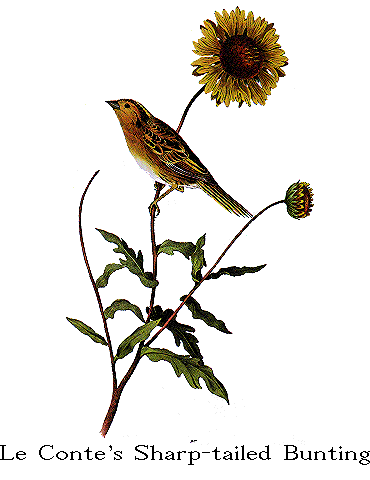Birds of America
By John James Audubon, F. R. SS. L. & E.
VOLUME VII.



Family
Genus

LE CONTE'S SHARP-TAILED BUNTING.
[LeConte's Sparrow.]
EMBERIZA LE CONTEII, Aud.
[Passerherbulus caudacutus.]

PLATE CCCCLXXXVIII.--MALE.
Although we procured several specimens of this pretty little Sharp-tailed
Finch, I have at present only one by me, a fine male, however, shot by
Mr. J. G. BELL, of New York, on the 24th of May.
At first sight one might easily mistake it for the Henslow Bunting, but on
comparing these two species, not only are distinct characters easily observed,
but the localities wherein the present species is found are different, as well
as its curious notes and general habits of keeping only among the long green
slender grasses that here and there happen to grow in patches of less or greater
extent along the margins of creeks found in the different parts of the prairies
through which we passed, whilst in the pursuit of the buffalo or bison.
So closely does it keep in the coverts which it resorts to, that it is
difficult to force it to rise on the wing, when only, it can be procured. Its
song is sharp, shrill and of a querulous nature. We never could find its nest
or young, and cannot give any further accounts of its habits.
I have named this interesting species after my young friend Doctor LE
CONTE, son of Major LE CONTE, so well known among naturalists, and who is, like
his father, much attached to the study of natural history.
LE CONTE'S SHARP-TAILED BUNTING, Emberiza Le Conteii, Aud.
4 (5 1/2)/8.
Upper Missouri prairies. Common.
Male.
Bill much more slender than in Emberiza Henslowii (AUD.); first quill the
longest, the rest diminishing rapidly. Tail emarginate and rounded, with the
feathers acute. Upper parts light yellowish-red, streaked with brownish-black,
the margins of the feathers and scapulars pale yellowish-white. Tail feathers
dusky, margined with light yellowish. Lower parts, with the cheeks and a broad
band over the eyes, fine buff. Medial line yellowish-white. The buff extending
to the femorals and along the sides, streaked with brownish-black; throat, neck,
and upper parts of the breast without any streaks, and plain buff.
Total length 4 (5 1/2)/8 inches; wing from flexure 2 1/8; first quill
longest; tail 1 7/8; bill along the ridge 3/8, along the edge nearly 1/2; both
mandibles dark blue, lighter along the edges. Eyes brown. Legs, feet and
claws, dull flesh colour. Tarsus (4 1/2)/8; middle toe 1/2, its claw 1/8; hind
toe 3/8, its claw rather more than 1/4.









